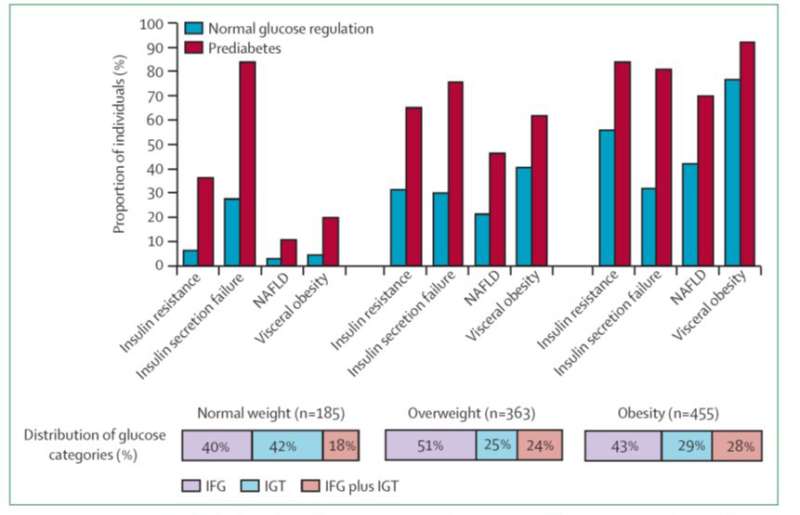Detection of four major phenotypes could modulate prediabetes risk

Prediabetes is associated with increased risk of diabetes, cardiovascular disease, dementia and cancer. However, the disease risk varies considerably among subjects. In a study reported in The Lancet Diabetes & Endocrinology, DZD scientists have summarized information from the literature and provided novel data indicating that the future determination of the four major phenotypes— fatty liver, visceral obesity and impaired production and action of insulin—may improve prediction and prevention of cardiometabolic risk in prediabetes.
In many countries, the prevalence of diabetes and prediabetes has reached epidemic numbers. In the USA and in China, more than half of the adult population already has elevated blood glucose levels. Prediabetic hyperglycemia is associated with increased risk of type 2 diabetes, cardiovascular disease, dementia and cancer. However, the disease risk considerably varies even in the state of prediabetes. This led scientists to study what parameters might explain this variability in disease risk in prediabetes.
Type 2 diabetes is a heterogeneous disease
Among scientists, it is well established that several pathophysiological mechanisms are involved in the development of type 2 diabetes. However, in a clinical setting, it is very difficult to disentangle these mechanisms that may be very useful to implement personalized prevention and treatment of diabetes. In diabetes diagnosed by elevated fasting or 2 hr glucose levels during a standard oral glucose tolerance test (OGTT), the prevalence and the sequence of appearance of impaired insulin production and impaired insulin secretion differ. This variability can already be observed in the prediabetic states isolated via impaired fasting glucose (IFG), isolated impaired glucose tolerance (IGT) or IFG+IGT combined.
At-Risk Phenotypes predict prediabetes and cardiovascular risk
In an analysis of data from 1003 subjects of the Tübingen Diabetes Family Study of whom 405 had prediabetes, the four at-risk phenotypes were independent determinants of prediabetes. Two phenotypes were not—BMI category (normal weight, overweight, and obese) and visceral obesity based on waist circumference. Except for visceral obesity, the other three at-risk phenotypes also predicted the regression from prediabetes to normal glucose regulation (NGR) during a lifestyle intervention. Among the individuals with prediabetes, fatty liver was the strongest determinant of increased carotid intima-media thickness, an early marker of atherosclerosis, followed by MRI-determined visceral obesity.
Phenotypes of prediabetes
Based on the emerging evidence for the existence of the very interesting extreme metabolic phenotypes metabolically healthy obesity and metabolically unhealthy normal weight, the scientist then studied the prevalence of the four at-risk phenotypes among the different BMI categories (normal weight, overweight, and obese) in subjects with NGR and prediabetes. They demonstrated that there are distinct signatures of these phenotypes among these BMI categories (figure). For example, while insulin secretion failure is by far the most prevalent at-risk phenotype in normal weight subjects with prediabetes, fatty liver and visceral obesity become more prevalent in overweight and obese subjects.
Conclusion: Phenotypes of prediabetes should be considered in prevention and treatment of cardiometabolic diseases
Norbert Stefan, the first author of the article, says," After initial classification of the glucose categories NGR and prediabetes, fatty liver, visceral obesity and impaired production and action of insulin should be included in assessment of cardiometabolic risk. If proven to be effective, this strategy could be included in medical guidelines about the prevention and treatment of diabetes and associated diseases."
Hans Häring, the last author of the study, adds, "The application of precise phenotyping strategies in clinical trials will also help to improve understanding of the pathophysiology of cardiometabolic diseases."
More information: The Lancet Diabetes & Endocrinology, DOI: 10.1016/S2213-8587
















